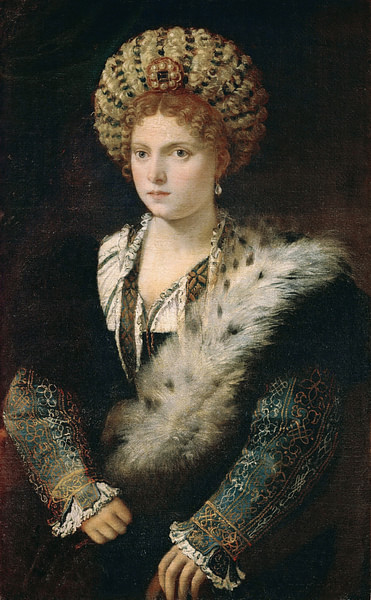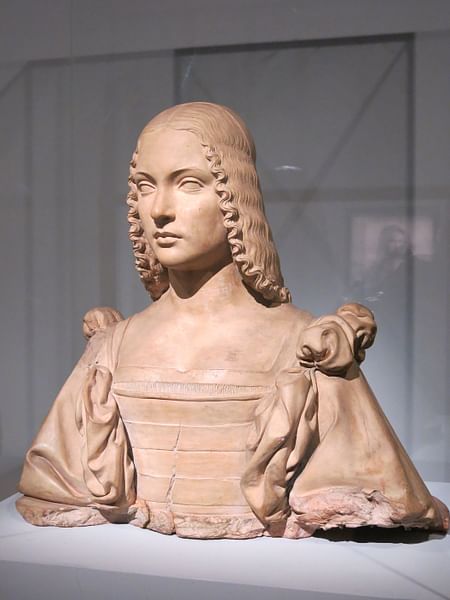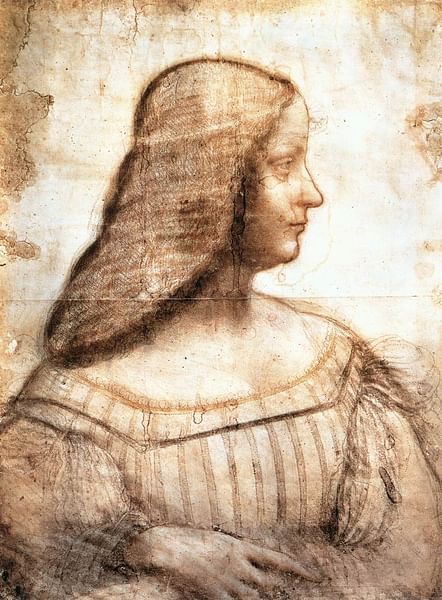
Isabella d’Este (l. 1474-1539), was the leading lady of Renaissance Italy who funded the works of such renowned artists as Leonardo da Vinci and Michelangelo. Many of the greatest Renaissance artworks would not exist today if not for the patronage of Isabella, who is also considered the female counterpart of the "Renaissance Men" who tirelessly worked to increase their knowledge.
Early Life
Isabella was the daughter of Duke Ercole d’Este of Ferrara and Eleanora d’Aragona who was the daughter of King Ferrante of Naples. Isabella was the eldest of six children; her sister Beatrice d’Este became the Duchess of Milan, and at the age of 6, Isabella was betrothed to Francesco II Gonzaga (1466-1519). Isabella lived her entire childhood knowing that she would one day be married to the Marquess of Mantua. Isabella was luckier than most girls of the Renaissance because her parents believed in equal schooling for boys and girls. This meant she grew up with the best classical education, becoming a talented singer, dancer, and lute player. She enjoyed horseback riding, card games, and was proficient in both Latin and Greek (although she only carried on with the Latin through adulthood).
On 11 February 1490, at the age of 15, Isabella married Francesco and became the Marchioness of Mantua. Isabella and Francesco had five children who reached adulthood; their daughter Eleonora Gonzaga became the Duchess of Urbino, their son Federico II Gonzaga succeeded his father as Marquess and then became the first Duke of Mantua, and their son Ercole became a cardinal of the Catholic church.
Isabella as Co-Regent of Mantua
When her husband Francesco was called away as a hired officer for some of the most powerful princes of Europe, Isabella took to managing the diplomatic and administrative needs of Mantua. Isabella proved herself to be both pragmatic and proficient whilst in charge of the region, although she was careful to present the decisions and actions she made as per her husband’s orders. When Isabella was acting as co-regent, she used her position to make changes and advise upon a multitude of areas within her region, which included criminal justice and the justice system, agricultural and land management, public health, marriages for court officials, and the defence of women's property and safety.
Although she was working within the limitations impressed upon women in the Renaissance period, Isabella still used what power and influence she could wield in the name of her husband as resourcefully as possible. Even with her need to work within the confines of her husband’s approval, Isabella still did a better job at running Mantua than Francesco. During their marriage, Francesco Gonzaga was engaged in an affair with Lucrezia Borgia, who was the wife of Isabella’s brother Alfonso, and the Duchess of Ferrara. It is thought that it was Francesco feeling like less of a man due to Isabella’s efficiency that was the catalyst for the affair. When Francesco was home, Isabella took the chance to travel as the diplomatic representative of their court and Mantua. She negotiated deals for the Gonzaga name and represented Mantua’s interests all throughout Italy.
The letters of Isabella d’Este give us a unique look into the lives of women in high positions in the Renaissance period. Throughout her life, Isabella wrote frequent correspondence to Francesco both when she was representing them at home and when she was travelling for business and pleasure. Her letters describing festivals and ceremonies from her travels are still some of the most detailed records to survive from her time. Isabella archived her letters, of which more than 12,000 survive, as if she wanted them to be preserved for as long as possible. Her correspondence while Francesco was away documented her activities in court as his proxy political leader in great detail.
In August 1509, Francesco was captured by the Venetians and held hostage, and during his time as a captive, until he was released in July of 1510, Isabella was the sole ruler of Mantua. During this time, Isabella successfully defended her region from foreign contenders for territories owned by the Gonzagas. When Francesco died in 1519, their son Federico succeeded his father as Marquess of Mantua and would eventually become the first Duke of Mantua. Since Federico was only 19 years old when his father died, Isabella took over the role of regent. For the next 20 years, she travelled both for fun and diplomacy, and in 1525 she purchased the estate of land known as Solarolo, where she acted as sole regent and could implement her own procedures and decisions. In 1527, she witnessed the sack of Rome and converted her home into a shelter for people needing refuge and ended up housing around 2,000 people. Perhaps in a stroke of luck, Isabella’s was one of the only homes which remained unscathed.
Patron of the Arts
Isabella was a skilled diplomat and was a formidable asset to the administrative and political landscape of Mantua, as saved for posterity through her letters with Francesco, but her legacy is as a patron and lover of the arts. It was not long after her marriage before Isabella began engaging with artists to decorate a special suite in her apartments, which she worked on for the next 20 years. This particular suite was for displaying the paintings, antiquities, cameos, portraits, books, and other precious items she had collected. The centre of her space was the studiolo or study which was decorated with paintings commissioned by Isabella, which boasted mythological scenes. The studiolo was connected by a staircase to a smaller room directly below it known as the grotta. This area was used to display her curated art pieces which exemplified her philosophical values her substantial learning and her personal tastes and virtues. It would have been a private space for Isabella to use to entertain select visitors of the court. After her husband died, she moved both the studiolo and the grotta to a different area of the palace.
To be a patron was to be a financial backer of a piece of art, and the patron was often also in control of the subject matter, size, and materials of the artwork. Isabella had her portrait painted by great artists such as Leonardo de Vinci and Titian and had art in her collection by Giovanni Bellini, Michelangelo, Francesco Francia, and many others. Isabella is also considered a potential subject for Leonardo da Vinci’s famous Mona Lisa.
Through her patronage of the arts and her general love of collecting pieces, she increased the debt of the Gonzaga family, and her artistic ambitions were more than she could afford. Luckily, she could use her status as an incentive for artists to produce work for her, since she was a prominent patron. This meant that prestige would be given to both the artist and the patron. Much like her correspondence to Francesco, Isabella also conceived detailed letters of her acquisitions which documents the extent and quality of her collection. These correspondences also give us the voice of Isabella in letter form, as well as an insight into art patronage and the processes of it in the Renaissance.








